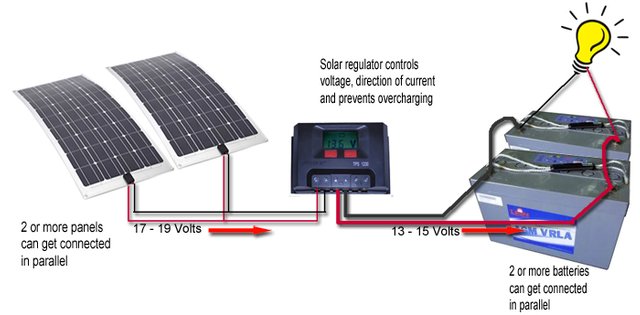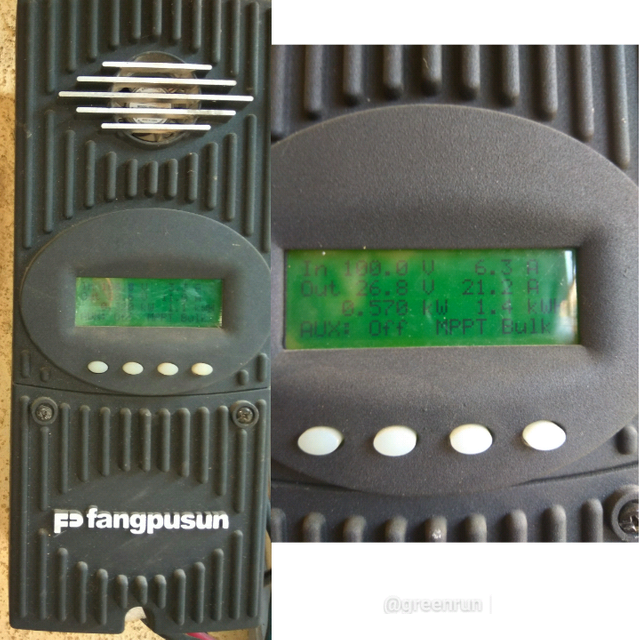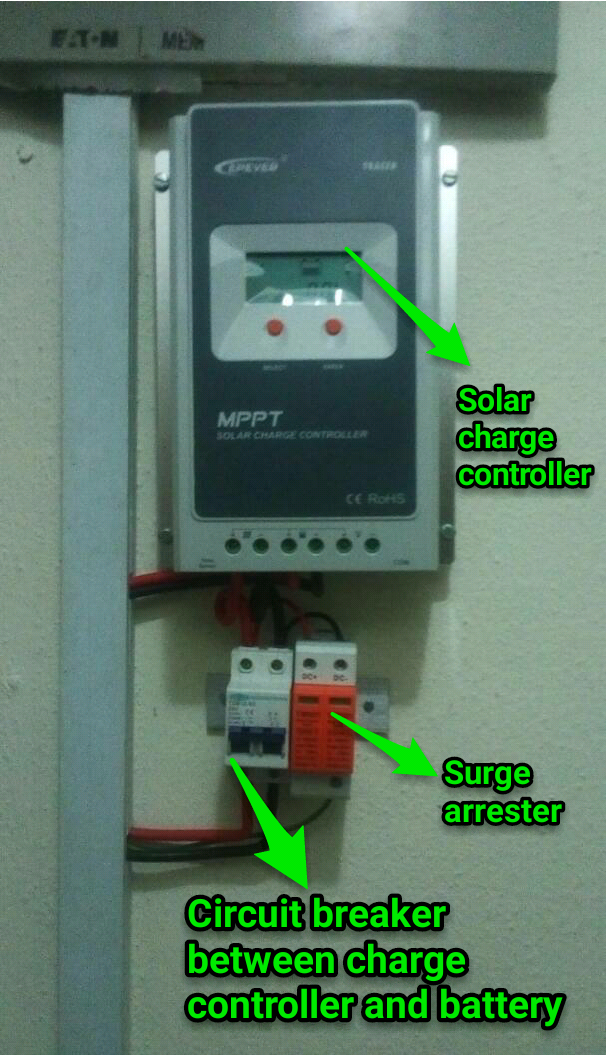This solar charge controller is a very vital part of a renewable solar energy system. Though, in my experience, I have noticed many new guys bypass it as something not that useful to be spending money on it.
What is a solar charge controller?
It is a solar charge regular designed to optimise the charging of batteries by regulating the current and voltage coming from the solar panel.
It is connected between the batteries and the solar panel/panels.

Source: A simplified diagram of a solar system showing the solar charge controller
This diagram is an oversimplified than what is obtainable in a real-life connection; there are circuit breakers between the battery and the charge controller and between the solar panel and charge controller.
Real-life connection looks like this image of a charge controller showing the connection of a circuit breaker and surger arrestor before the batteries (image credit: me) |
As I mentioned earlier in my article The Battery Care in Renewable Energy: The Use of Multi-stage Battery Charging System, there is need to charge the batteries properly to avoid getting their lifespan reduced.
To do that in a solar setup a suitable charge controller is used.
Principle of operation
How a solar charge controller works is dependent on the type of controller. There are two types of solar charge controller, there is
- Pulse Width Modulator (PWM) controllers and;
- Maximum Power Point Tracking (MPPT) Solar Charge Controllers.
PWM Controllers
The pulse width modulation transfers pulses of electricity to the battery at varying intervals. As each pulse ends, the controller switches off and measures the battery charge capacity and then depending on the charge level adjusts the output values to be the same. It behaves like an intelligent switch between the solar panels and batteries through turning on and off thus controlling the current and voltage that goes to the battery.
This method ensures that voltage from the solar panel arrays would always be pulled down to near that of the battery's voltage.
For example, if you are using a low-cost PWM solar charge controller on a 24V battery bank and 250W solar panel.
During charging, the 250w solar panel is connected to the battery.
Let's assume you have an 8A 250w solar panel connected to a 24V battery bank through a low-cost PWM charger. During charging, we would have the following power.
P= IV
P= 24 x 8 = 192W
This system effectively loses 52W (250-192)W
This loss even gets worse during cloudy days.
So you should give it a thought the next time you are offered a PWM charge controller very much cheaper than MPPT by that dishonest salesman who assures you they are the same. That is a lie.
The PWM charge controller is a low-cost solution for small systems only when solar cell temperature is moderate to high (between 45°C and 75°C). To fully utilise the potential of the MPPT controller, the solar panel array voltage should be noticeably higher than the battery voltage.
MPPT Charge Controller
This controller is a more sophisticated system that comes at a higher cost too. A typical PWM to MPPT charge controller's price is usually in the ratio of 1:2 or something close or more.
The MPPT charge controller is most recommended for large solar panel arrays where the harvested input voltage is considerably higher than the battery voltage. It transforms this "excess" voltage into current and thus charges the battery faster.
Take a look at this MPPT solar charge controller made by Fangpusun that my friend uses.

MPPT solar charge controller in action (Image taken by me)
| Measured quantity | Input | Output) |
|---|---|---|
| Voltage (V) | 100.0 | 26.8 |
| Current (A) | 6.3 | 21.2 |
| Wattage (W) | 570 |
If you could see the displayed parameters, (apologies for the poor picture quality). You would notice these.
Notice that the input voltage coming in from solar panel is 100V This is far higher than the battery voltage (26.8V), this is a 24Volt DC system. But the MPPT converts this excess voltage to current (21.2A) making the batteries charge faster.
The MPPT can adjust its input voltage to harvest the maximum power coming in from the solar array and converting it to appropriate voltage and current to optimally charge the system batteries.
If there is any questions, correction or recommendation, please drop it in the comment section. Thank you for reading.
Ref: 1.


Downvoting a post can decrease pending rewards and make it less visible. Common reasons:
Submit
Thank you.
Downvoting a post can decrease pending rewards and make it less visible. Common reasons:
Submit
Merry Christmas
@Resteemed
Downvoting a post can decrease pending rewards and make it less visible. Common reasons:
Submit
Thank you very much.
Downvoting a post can decrease pending rewards and make it less visible. Common reasons:
Submit
Chai, plenty mathematics
Downvoting a post can decrease pending rewards and make it less visible. Common reasons:
Submit
Where is the maths? :)
Downvoting a post can decrease pending rewards and make it less visible. Common reasons:
Submit
Smiles, somewhere in the post but not to worry, i got something
Downvoting a post can decrease pending rewards and make it less visible. Common reasons:
Submit
Ride on :)
Downvoting a post can decrease pending rewards and make it less visible. Common reasons:
Submit
When I go through your post I'm glad that this is coming from a Nigerian.
Continue to make the entire Nigeria steamians proud with your enriching post.
Downvoting a post can decrease pending rewards and make it less visible. Common reasons:
Submit
Thank you for the kind compliments.
Downvoting a post can decrease pending rewards and make it less visible. Common reasons:
Submit
i think MPPT controllers also stabilizes 2 times the number of batteries that a regular PWM controller would
Downvoting a post can decrease pending rewards and make it less visible. Common reasons:
Submit
Stabilises? Sorry, I do not understand your reply.
Downvoting a post can decrease pending rewards and make it less visible. Common reasons:
Submit
I have learnt alot from this your post
Downvoting a post can decrease pending rewards and make it less visible. Common reasons:
Submit
Excellent
Downvoting a post can decrease pending rewards and make it less visible. Common reasons:
Submit
The uncountable knowledge we have acquired in this community is enormous and when it comes to that, this post is not an exception.
#steem-medic
Downvoting a post can decrease pending rewards and make it less visible. Common reasons:
Submit
Thanks, @theheralds, reading your comments is always a joy. Merry Christmas to your beautiful family and you.
Downvoting a post can decrease pending rewards and make it less visible. Common reasons:
Submit
Pleasure is mine
Downvoting a post can decrease pending rewards and make it less visible. Common reasons:
Submit
Wow, great post
Downvoting a post can decrease pending rewards and make it less visible. Common reasons:
Submit
Thanks for reading.
Downvoting a post can decrease pending rewards and make it less visible. Common reasons:
Submit
After reading all these, I must say it's a relief I almost have no business with this. I don't understand half the things mentioned there despite your simplification. Maybe I would have if... But no worries, a professional will handle it. Like the lady said, "plenty mathematics"... Obviously not our field so . Great post as always nonetheless
Downvoting a post can decrease pending rewards and make it less visible. Common reasons:
Submit
You should be a user at least unless of course, you happen to reside in that part of Nigeria where there is constant supply of electric power :)
Life contains a lot of mathematics just that when people see equations they become wary and afraid. You pay the taxi man, and you do a lot of maths to get your correct balance. No one thinks of it as maths until you see equations :)
If Tony enters a cab at point A and travels to point B, which is 2km, and his fare is N200. He gave the driver N500, what would be his change if he is to travel an additional 1 km?
You may just say N200 without thinking.
But when you see below you may become uncomfortable
Let's say the distance from point A to B = Y= 2km
Bill for Y travel = N200
Let's calculate the distance per km in naira= 200/2= N100
Therefore 1KM travel = 100
He had travelled for total of 3km= 3 * 100 = 300
He gave the driver N500. Therefore, his balance is N500 - N300= N200
His balance is N200
But you already know this, yet you say you do not know mathematics? Lol
Downvoting a post can decrease pending rewards and make it less visible. Common reasons:
Submit
😂😂😂 This your calculation made my day. It actually made me laugh out loud. It is exactly all these long kilometer stories they tell to complicate issues that makes me run from mathematics. Biko, I'd rather calculate in English; I.E without thinking.😁 If that means I know maths, then ain't I lucky?
I can tell you there is almost no part of Nigeria with that kind of constant power supply you mean
Downvoting a post can decrease pending rewards and make it less visible. Common reasons:
Submit
Good to hear that you calculate in English :)
Rock on.
Downvoting a post can decrease pending rewards and make it less visible. Common reasons:
Submit
👍 you too
Downvoting a post can decrease pending rewards and make it less visible. Common reasons:
Submit
wow you have done some great research over it amazing !!!
Downvoting a post can decrease pending rewards and make it less visible. Common reasons:
Submit
I must admit that you got my loyal vote as I am having no clue about the matter. So I really can't say something aditional, clever or educational :-)
I hope you don't mind - LOL
Downvoting a post can decrease pending rewards and make it less visible. Common reasons:
Submit
I do not mind at the very least. Good to see you here.
Downvoting a post can decrease pending rewards and make it less visible. Common reasons:
Submit
I was going to talk on charge controllers soon but I am glad you just did justice to it.. Nice work @greenrun. My solar post too is almost done.
Downvoting a post can decrease pending rewards and make it less visible. Common reasons:
Submit
Very educative one here
The MPPT embedded charge controllers have really made the harvesting of solar energy easy and super effective. My solar power system really improved in performance when a MPPT charge controller was attached to it. Although it was a project by my roommate to acquire live data of the solar charge system but it has been a very important addition to the system and i have been praying his project extends as long as possible so we can enjoy it.
Downvoting a post can decrease pending rewards and make it less visible. Common reasons:
Submit
You can own a portable system. Check out LUMOS by MTN if you are in Nigeria. Thanks for your detailed reply.
Downvoting a post can decrease pending rewards and make it less visible. Common reasons:
Submit
Well, i know about LUMOS but its not like what i use. I have a charging system of 2 150W mono panels, 1KVA inverter and a 100AH battery... We use it to power my room in the hostel (I'm still a student)
Downvoting a post can decrease pending rewards and make it less visible. Common reasons:
Submit
That's a descent power supply for a student. I assume you only power PCs and electric bulbs. That's even better than Lumos as it only have one 60W solar panel. Though their battery may be better than yours since they use lithium-ion batteries.
Downvoting a post can decrease pending rewards and make it less visible. Common reasons:
Submit
Great Post, always educative
Downvoting a post can decrease pending rewards and make it less visible. Common reasons:
Submit
Thank you.
Downvoting a post can decrease pending rewards and make it less visible. Common reasons:
Submit
Thanks you simplified it very much great details :)
Downvoting a post can decrease pending rewards and make it less visible. Common reasons:
Submit
Ever blazing...blaze on!
Downvoting a post can decrease pending rewards and make it less visible. Common reasons:
Submit